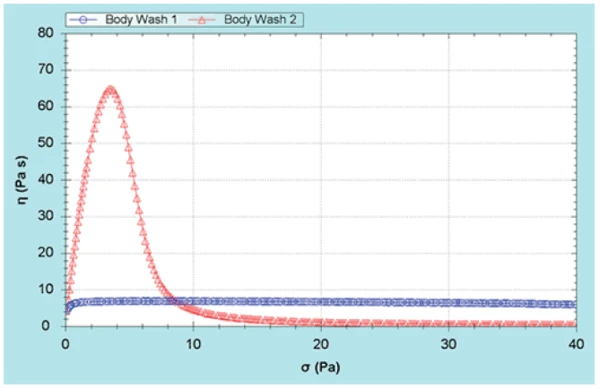Introduction
Many complex fluids, such as network forming polymers, surfactant mesophases and concentrated emulsions do not flow until the applied ContrainteLa Contrainte est définie par un niveau de force appliquée sur un échantillon d’une section bien définie. (Contrainte = force/surface). Les échantillons qui possèdent une section rectangulaire ou circulaire peuvent être comprimés ou étirés. Les matériaux élastiques comme les élastomères peuvent être étirés jusqu’à 5 à 10 fois leur longueur initiale.stress exceeds a certain critical value, known as the Yield StressYield stress is defined as the stress below which no flow occurs; literally behaves like a weak solid at rest and a liquid when yielded.yield stress. Materials exhibiting this behavior are said to be exhibiting yield flow behavior. The Yield StressYield stress is defined as the stress below which no flow occurs; literally behaves like a weak solid at rest and a liquid when yielded.yield stress is therefore defined as the stress that must be applied to the sample before it starts to flow. Below the Yield StressYield stress is defined as the stress below which no flow occurs; literally behaves like a weak solid at rest and a liquid when yielded.yield stress the sample will deform elastically (like stretching a spring), above the Yield StressYield stress is defined as the stress below which no flow occurs; literally behaves like a weak solid at rest and a liquid when yielded.yield stress the sample will flow like a liquid.
Most fluids with Yield StressYield stress is defined as the stress below which no flow occurs; literally behaves like a weak solid at rest and a liquid when yielded.yield stress can be considered as a structural skeleton that extends over the entire volume of the system. The strength of the skeleton is governed by the structure of the dispersed phase and its interactions. Normally, the continuous phase is low in viscosity, however, high volume fractions of a dispersed phase can increase the viscosity by a thousand times and induce solid-like behavior at rest.
When a complex fluid that exhibits yield behavior is sheared at low shear rates, in the range between 0.01 to 0.1 s-1 and below its critical strain, the system is subjected to work hardening. This is characteristic of solidlike behavior and results from elastic elements being stretched in the shear field. When such elastic elements approach their critical strain the structure begins to break down causing Shear ThinningThe most common type of non-Newtonian behavior is shear thinning or pseudoplastic flow, where the fluid viscosity decreases with increasing shear.shear thinning (strain softening) and consequent flow. The stress at which this catastrophic breakdown of the structural skeleton occurs is the yield stress.
There are a number of experimental tests for determining yield stress. One of the quickest and easiest methods is to perform a shear stress sweep and determine the stress at which a viscosity peak is observed. Prior to this viscosity peak, the material is undergoing elastic deformation. This peak therefore represents the point at which the elastic structure breaks down (yields) and the material begins to flow. This is shown in Figure 1.

This application note shows methodology and data from a stress ramp test for two shower gel (bodywash) products with different formulations.
Yield stress is defined as the stress that must be applied to the sample before it starts to flow.
Experimental
- Two commercial shower gel products were evaluated; one containing surfactant only and the other containing surfactant and an associative thickener.
- Rotational rheometer measurements were made using a Kinexus rheometer with a Peltier plate cartridge and a cone and plate measuring system1, and utilizing standard pre-configured sequences in rSpace software.
- A standard loading sequence was used to ensure that the sample was subject to a consistent and controllable loading protocol.
- A shear stress ramp was performed, and the data was analyzed using a peak analysis to determine the yield stress.
- All rheology measurements were performed at 25°C.
Results and Discussion
Figure 2 shows the viscosity against stress curves for the two shower gel samples in the stress ramp test. Data for Bodywash 2 shows a clear viscosity peak in the stress ramp test, while data for Bodywash 1 is relatively flat. This implies that Bodywash 2 is exhibiting strain hardening associated with a yield stress while bodywash 1 is behaving like a liquid with a zero shear viscosity. The measured yield stress for Bodywash 2 was 4 Pa. In some instances, viscoelastic liquids may show a slight peak in viscosity even though they do not possess a true yield stress.
In this case, user discretion may be required or alternatively confirmation using an alternative test such as a creep test or a table of shear rate test to confirm the absence of a zero shear viscosity2.

Conclusion
Two shower gel products were compared using a yield stress ramp test on a rotational rheometer. Bodywash 2, which contains an associative thickener, was shown to have a yield stress of 4 Pa. Bodywash 1 showed no peak in viscosity in the stress ramp test and was therefore considered to have no yield stress.
1Please note that testing can be undertaken with cone and plate or parallel plate geometry – with the latter being preferred for dispersions and emulsions with large particle sizes. Such material types may also require the use of serrated or roughened geometries to avoid artefacts relating to slippage at the geometry surface.